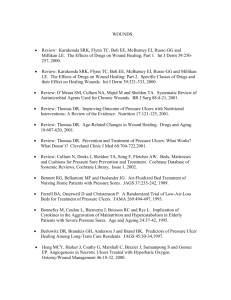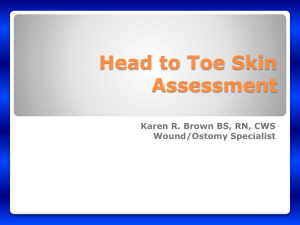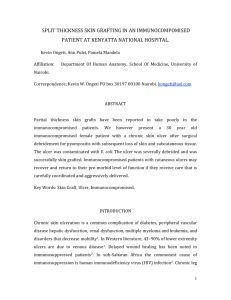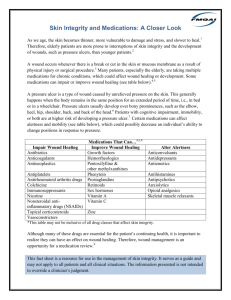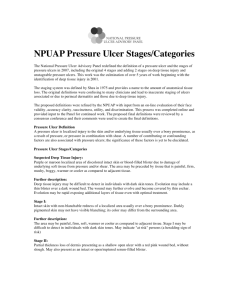Chronic Wound Care Guidelines
advertisement
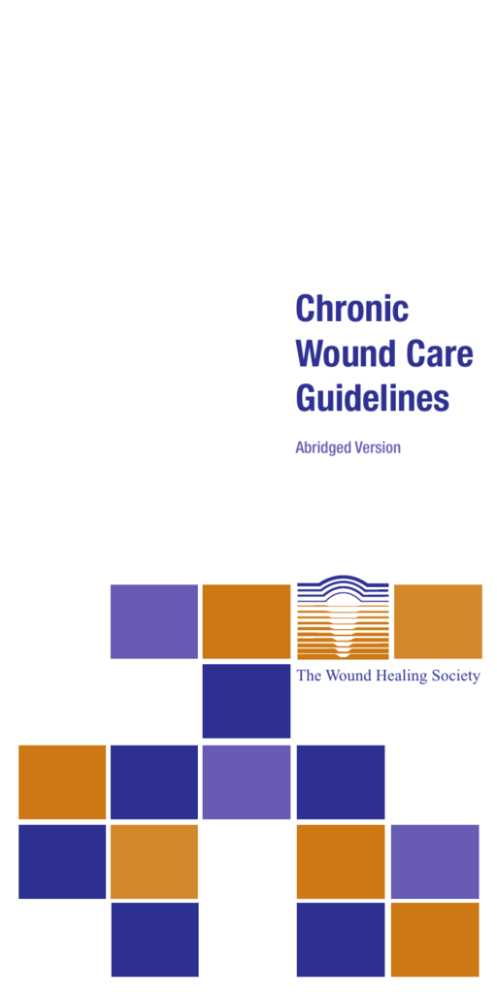
Chronic Wound Care Guidelines Abridged Version The Wound Healing Society Table of Contents Foreword..............................................................2 Venous Ulcer ......................................................4 Pressure Ulcer ..................................................10 Diabetic Ulcer ..................................................16 Arterial Insufficiency Ulcer ..............................22 References .........................................................28 The Wound Healing Society FOREWORD The publication of the Wound Care Guidelines by the Wound Healing Society in the December 2006 issue of Wound Repair and Regeneration represents the culmination of a three-year effort involving numerous individuals and entities. As the Principal Investigator and Chief Editor of this work, I think that a brief history of the genesis and completion of this project is absolutely necessary. In addition, it allows for the recognition of the effort by so many into the development of this project. In early 2003, the Wound Healing Foundation, under the leadership of Dr. Elof Eriksson, put out a request for proposal (RFP) for a project to formulate and publish “Minimal Standards for the Diagnosis and Treatment of Chronic Wounds: General and Specific.” The RFP emphasized that the most common chronic wounds—pressure ulcers, venous stasis ulcers and diabetic foot ulcers—are increasing in prevalence in the U.S. population, owing primarily to an ever-increasing number of elderly patients. Moreover, despite many recent advances in wound care, the challenge of managing chronic wounds is compounded by the current lack of uniformly accepted diagnostic methods to evaluate outcomes and consensus on clearly defined, comprehensive wound care standards. The WHS was extremely gratified when its proposal was accepted. The committees and respective Chairs were selected and charged with the necessary research and writing in June 2005. The successful completion of their task within a short period of six to eight months bespeaks of their hard work, dedication to the goals of the project and unwavering commitment. Several unique features of this project need to be stressed. First, consensus was the order of the day and was maintained throughout: in the broad and comprehensive research of existing literature; in the make-up of work groups to include all specialties, disciplines, professional degrees or societies (various clinical fields such as dermatology, endocrinology, vascular surgery, plastic surgery, podiatric medicine, geriatrics, nursing, dietetics/nutrition, rehabilitative services and prosthetics are all 2 represented); in the application of Delphi process in that the vast majority of the group had to be in agreement with any pronouncement or recommendation; and, finally, in the seeking of input from all interested parties, societies and industry at publicly held forums on the NIH campus in October 2005 and February 2006. The astute reader will notice that the term “standard” was dropped in favor of the term “guideline.” It was felt that the latter term more accurately reflected the intent, the frequent lack of strong evidence or the legal implication of the former term. Unique to these documents are: the inclusion of animal data as reflective of biological, if not necessarily clinical, evidence; the lack of any “agenda,” as no industrial or other interest group or funding was sought; and, finally, the inclusion of clinicians, academicians and bench scientists in the group. The publication of the guidelines represents only a beginning. The WHS has formed a “Guideline Update Committee” chaired by Dr. Martin Robson. Its duties include the continued examination of the validity and currency of the documents, as well as their periodic update and republication. I would like to conclude by recognizing several individuals who have helped and encouraged me in this project: Dr. Elof Eriksson, whose unwavering trust, help and friendship have been invaluable and who remains as committed today as he was in 2003 to the value of this project; his efforts in diplomacy and science are a constant source of inspiration; Dr. Lillian Nanney, whose faith and trust in me was an impetus to complete the project; to the Chairs of the four committees: Drs. Martin Robson, David Steed, Harriet Hopf, Joie Whitney and Linda Phillips, all of whom kept their focus, the time frame imposed and required virtually no “urgings” on my part; all committee members whose work is truly represented here. Adrian Barbul, MD, FACS President, The Wound Healing Society 3 VENOUS ULCER 1. Diagnosis 1.1 Arterial disease should be ruled out: • Pedal pulses are present ABI > 0.8. • ABI < 1.0 suggests vascular disease; if ABI < 0.7 then compression therapy is contraindicated. • In elderly patients, diabetic patients or patients with ABI > 1.2, Toe:brachial index > 0.6 or transcutaneous oxygen pressure of > 30 mm Hg may help to suggest adequate arterial flow. 1.2 Color duplex ultrasound scanning or Valsalva maneuver is useful in confirming venous etiology. 1.3 If suspecting sickle cell disease, diagnose with sickle cell prep and hemoglobin electrophoresis. 1.4 If ulcer is older than three months or not responsive after six weeks of therapy, biopsy for histological diagnosis (possible malignancy or other disease). 1.5 If worsening despite treatment or excessively painful, consider other diagnoses such as pyoderma gangrenosum, IgA monoclonal gammopathies, Wegener's granulomatosis, cutaneous chronic granulomatous disease and mycobacterial or fungal etiologies (high suspicion for ulcers with dark color, blue/purple border, concomitant with systemic disease such as Crohn's disease, ulcerative colitis, rheumatoid arthritis, other collagen vascular diseases, leukemia). Specific cultures for mycobacteria and/or fungi are useful, as biopsies for histology. 2. Lower Extremity Compression 2.1 Use of Class 3, high-compression system is indicated. The degree of compression must be modified when mixed venous/arterial disease is confirmed during the diagnostic work-up. 2.2 Intermittent pneumatic leg compression (IPC) can be used with or without compression (other option for patients who cannot or will not use adequate compression). Because venous hypertension is an ongoing condition, a degree of compression therapy should be continued constantly and forever. (See Long-Term Maintenance guidelines on Page 9.) 4 VENOUS ULCER 3. Infection Control Debridement 3.1 Remove necrotic, devitalized tissue by sharp, enzymatic, mechanical, biological or autolytic debridement. Infection Assessment 3.2 If infection is suspected in a debrided ulcer, or if epithelialization from the margin is not progressing within two weeks of debridement and initiation of compression therapy, determine the type and level of infection in the debrided ulcer by tissue biopsy or by a validated quantitative swab technique. Treatment 3.3 If ≥ 106 CFU/g of tissue or any beta hemolytic streptococci, use topical antimicrobial (discontinue once in bacterial balance to minimize cytotoxicity and development of resistance). Systemically administered antibiotics do not effectively decrease bacterial levels in granulating wounds; however, topically applied antimicrobials can be effective. 3.4 Cellulitis (inflammation and infection of the skin and subcutaneous tissue most commonly due to streptococci or staphylococci) around ulcer should be treated with systemic gram-positive bactericidal antibiotics. 3.5 Minimize the tissue level of bacteria, preferably to ≤ 105 CFU/g of tissue, with no beta hemolytic streptococci in the venous ulcer prior to attempting surgical closure by skin graft, skin equivalent, pedicled or free flap. 5 VENOUS ULCER 4. Wound Bed Preparation 4.1 Examine patient as a whole to evaluate and correct causes of tissue damage: A) Systemic diseases (autoimmune diseases, major surgery, chronic smoking) and medications (immunosuppressive drugs and systemic steroids) B) Nutrition C) Tissue perfusion and oxygenation Debridement 4.2 Perform initial debridement and maintenance debridement (sharp, enzymatic, mechanical, biological or autolytic). Choose method of debridement depending on the status of the wound, the capability of the healthcare provider and the overall condition of the patient. Cleansing 4.3 Cleanse wound initially and at each dressing change using a neutral, nonirritating and nontoxic solution. Routine wound cleansing should be accomplished with a minimum of chemical and/or mechanical trauma. Sterile saline or water is usually recommended. Tap water should only be used if the water source is reliably clean. A nontoxic surfactant may be useful, as may fluid delivered by increased intermittent pressure. Documentation of Wound History 4.4 Document wound history, recurrence and characteristics (location, staging, size, base, exudates, infection condition of surrounding skin and pain). The rate of wound healing should be evaluated to determine if treatment is optimal. 6 VENOUS ULCER 5. Dressings 5.1 Use dressing that maintains a moist wound healing environment. 5.2 Use clinical judgment to select moist wound dressing that facilitates continued moisture. Wet-to-dry dressings are not considered continuously moist and are an inappropriate wound dressing selection. 5.3 Select dressing to manage exudates and protect peri-wound skin. 5.4 Select a dressing that stays in place, minimizes shear and friction, and does not cause additional tissue damage. VENOUS ULCER PATIENTS ARE PARTICULARLY SUSCEPTIBLE TO CONTACT DERMATITIS RELATED TO TOPICAL THERAPIES. 5.5 Select dressing that is cost-effective and appropriate to the ulcer etiology, the setting and the provider. Consider healthcare provider time, ease of use and healing rate, as well as the unit cost of the dressing. 6. Surgery 6.1 Skin grafting without attention to the underlying venous disease is not a long-term solution and is prone to recurrent ulceration. 6.2 Subfascial endoscopic perforator surgery (SEPS) is the procedure of choice to address underlying venous pathologic etiology (with or without skin grafting or use of a bilayered artificial skin). 6.3 Less extensive surgery on the venous system, such as superficial venous ablation, endovenous laser ablation or valvuloplasty, especially when combined with compression therapy, can be useful in decreasing the recurrence of venous leg ulcers. Procedures that are less extensive than deep ligation of multiple perforating veins can help to decrease venous hypertension when combined with an adequate compression system. 6.4 Free flap transfer with microvascular anastomoses can benefit recalcitrant venous leg ulcers with severe lipodermatosclerosis by allowing wide excision of diseased tissue and providing uninjured venous valves in the transferred tissue. 7 VENOUS ULCER 7. Use of Adjuvant Agents This section will be limited to recommending the agents that have sufficient data showing them to be useful in venous ulcers. More studies are needed to clarify the benefits of other agents in the treatment of venous ulcers. Examples of such other agents currently under investigation include stem cells, artificial skin, grafts, topical oxygen, electrical stimulation, negative pressure, laser therapy, phototherapy, ultrasound and prostaglandins. Please refer to the complete guidelines for the current knowledge on each of these. Devices 7b.1 Bilayered artificial skin, in conjunction with compression therapy, is better than compression and a simple dressing. 7b.2 Cultured epithelial autografts or allografts do NOT improve venous leg ulcer healing. They are useful for burns but not durable enough for venous leg ulcers. 7b.5 Laser therapy, phototherapy and ultrasound therapy have NOT been shown statistically to improve venous leg ulcers. Systemic 7c.1 Pentoxifylline used in conjunction with compression therapy improves healing of venous leg ulcers. 7c.5 Oral zinc supplementation is NOT useful in the treatment of venous leg ulcers. 8 VENOUS ULCER 8. Long-Term Maintenance 8.1 Patients with healed or surgically repaired venous ulcers should use compression stockings constantly and forever. Most treatments do not eliminate the underlying increased ambulatory venous pressure (venous hypertension), so a degree of compression is necessary long-term. 8.2 Exercises to increase calf muscle pump function have been demonstrated to be helpful in long-term maintenance and venous ulcer prevention. Calf muscle pump function has been shown to be improved with exercises. 9 PRESSURE ULCER 1. Positioning and Support Surfaces 1.1 Establish a repositioning schedule and avoid positioning on ulcer. 1.2 Maintain the head of the bed at the lowest degree of elevation consistent with medical conditions and other restrictions. Limit the amount of time the head of the bed is elevated and elevate only when there is a compelling medical indication (e.g., one to two hours after tube feeding, or with severe respiratory or cardiac compromise). 1.3 Assess all patients for risk of pressure ulcer; use pressurereducing surface for at-risk patients, since they are superior to standard hospital mattresses. 1.4 A static support surface may be appropriate for patients who can assume a variety of positions. 1.5 A dynamic support surface may be appropriate for patients who cannot assume a variety of positions. 1.6 Stage 3, 4 or multiple pressure ulcers: low-air-loss or airfluidized bed may be indicated. 1.7 Avoid prolonged sitting for at-risk patients. Reposition at least every hour or return to bed. 1.8 Use seat cushion for pressure reduction in sitting position (avoid donut-type devices since they have been shown to increase venous congestion and edema). 2. Nutrition 2.1 Perform nutritional assessment (weight, pre-albumin level and serum albumin level). 2.2 Encourage dietary intake or supplementation if malnourished and at risk for PU. 2.3 Ensure adequate dietary intake to prevent malnutrition (if compatible with individual’s wishes). 2.4 If still inadequate, use nutritional support (tube feeding) to place patient in positive nitrogen balance (30-35 cal/kg/day and 1.25-1.5g protein/kg/day). 2.5 Give vitamin and mineral supplements if deficiencies are confirmed or suspected. 10 PRESSURE ULCER 3. Infection Control 3.1 Treat distant infections (e.g. urinary tract, cardiac valves, cranial sinuses) with appropriate antibiotics in pressure ulcer-prone patients or patients with established ulcers. Debridement 3.2 Remove necrotic, devitalized tissue by sharp, enzymatic, mechanical, biological or autolytic debridement. Infection Assessment 3.3 If infection is suspected in a debrided ulcer, or if contraction and epithelialization from the margin are not progressing within two weeks of debridement and relief of pressure, determine the type and level of infection in the debrided ulcer by tissue biopsy or by a validated quantitative swab technique. Cultures should be performed to isolate both aerobic and anaerobic bacteria. Treatment 3.4 If ≥ 106 CFU/g of tissue or any beta hemolytic streptococci, use topical antimicrobial (discontinue once in bacterial balance to minimize cytotoxicity and development of resistance). Systemically administered antibiotics do not effectively decrease bacterial levels in granulating wounds; however, topically applied antimicrobials can be effective. 3.5 Obtain bacterial balance (< 105 CFU/g of tissue and no beta hemolytic streptococci) in the pressure ulcer prior to attempting surgical closure by skin graft, direct wound approximation, pedicled or free flap. 3.6 Obtain bone biopsy for culture and histology in cases of suspected osteomyelitis associated with a pressure ulcer. 3.7 Once confirmed, osteomyelitis underlying a pressure ulcer should be adequately debrided and covered with a flap containing muscle or fascia. (Antibiotic choice, guided by culture results, should be used for three weeks). 11 PRESSURE ULCER 4. Wound Bed Preparation 4.1 Examine patient as a whole to evaluate and correct causes of tissue damage: A) Systemic diseases (autoimmune diseases, major surgery, chronic smoking, sepsis, organ failure, major trauma/burns, diabetes, uncontrolled vasculitis and pyoderma gangrenosum) and medications (immunosuppressive drugs and systemic steroids) B) Nutrition (weight, pre-albumin level, serum albumin level and sufficient protein intake) C) Tissue perfusion and oxygenation (dehydration, cold, stress and pain decrease tissue perfusion; smoking decreases tissue oxygen) Debridement 4.4 Perform initial debridement and maintenance debridement (sharp, enzymatic, mechanical, biological or autolytic). Methods of debridement (choose depending on the status of the wound, the capability of the healthcare provider and the overall condition of the patient. However, it is common to combine methods of debridement in order to maximize the healing rates). Sharp: When the goal is to achieve fast and effective removal of large amounts of necrotic tissue. Contraindicated if lack of expertise, inadequate vascular supply to the wound and absence of systemic antibacterial coverage in systemic sepsis. Relative contraindication is bleeding disorders or anticoagulation therapy. Mechanical: High- or low-pressure streams or pulsed lavage may be quite effective, provided the pressure does not cause trauma. Effective irrigation pressures range from 4 to 15 psi. A 30-mL syringe filled with saline can be used to flush a wound through an 18-gauge catheter. Irrigation pressures below 4 psi may not be effective to cleanse the wound and pressures greater than 15 psi may cause trauma 12 PRESSURE ULCER and drive the bacteria into the tissue. Whirlpools may be used initially to loosen and remove debris, bacteria, exudates and necrotic tissue. Prolonged use and periods of wetness may macerate the tissue or be associated with bacterial contamination. Enzymatic: Topical application of exogenous enzymes. Autolytic: Through use of moist interactive dressings. If tissue autolysis is not apparent in one to two weeks, another debridement method should be used. Autolytic debridement is not recommended for infected wounds or very deep wounds that require packing. Cleansing 4.5 Cleanse wound initially and at each dressing change using a neutral, nonirritating, nontoxic solution. Accomplish with minimal trauma. A nontoxic surfactant may be useful as may fluid delivered by increased intermittent pressure. Mild soap (nonperfumed, without added antibacterials and at skin pH: 4.5-5.7) and water for cleansing, used regularly, is effective, safe and cheap. Use sterile saline or water; tap water if reliably clean. Wound antiseptic agents, e.g. hydrogen peroxide, hypochlorite solution, acetic acid, chlorhexamide, providone/iodine, cetrimide and others have antibacterial properties, but are all toxic to healthy granulation tissue. Other 4.6 Infection control should be achieved by reducing bacterial burden and achieving bacterial balance. 4.8 Achieve local moisture balance by management of exudates. Documentation of Wound History 4.9 Document wound history, recurrence and characteristics (location, staging, size, base, exudates, infection condition of surrounding skin and pain). The rate of wound healing should be evaluated to determine if treatment is optimal. 13 PRESSURE ULCER 5. Dressings 5.1 Use dressing that maintains a moist wound healing environment. 5.2 Use clinical judgment to select moist wound dressing that facilitates continued moisture. Wet-to-dry dressings are not considered continuously moist and are an inappropriate wound dressing selection. 5.3 Select dressing to manage exudates and protect peri-wound skin. 5.4 Select dressing that stays in place and minimizes shear, friction, skin irritation and additional pressure. 5.5 Select dressing that is cost-effective and appropriate to the ulcer etiology, the setting and the provider. Consider healthcare provider time, patient care goals and resources, ease of use and healing rate, as well as the unit cost of the dressing. 6. Surgery 6.1 Irregular wound extensions forming sinuses or cavities must be explored, and unroofed and treated. 6.2 Necrotic tissue must be debrided (See guideline 4.4 in Wound Bed Preparation on page 12). 6.3 Infected tissue must be treated by topical antimicrobials, systemic antibiotics or surgical debridement (See guidelines 3.2 and 3.4 in Infection on page 11). Only tissue with a low bacterial count (≤ 105 CFU/g) and with no beta hemolytic streptococcus will proceed to closure. 6.4 Underlying bony prominence and fibrotic bursa cavities should be removed. 6.5 Bone excision must not be excessive. 6.6 Fecal or urinary diversions are rarely needed to obtain a healed wound. 6.7 Consider radical procedures (amputation and hemicorpectomy) only in rare and extreme cases. 14 PRESSURE ULCER 6.8 A pressure sore should be closed surgically if it does not respond to wound care and there is no other contraindication to the surgical procedures. Exceptions may include the elderly or patients with a fatal illness, for whom palliative, local wound care is more appropriate. 6.9 Composite tissue closure leads to the best chance of sustained closure, although recurrence and recidivism are continuing problems. The most durable wound closure fills the ulcer with bulk and provides padding over the underlying structures with a tension-free closure. 6.10 Management to address muscle spasm and fixed contractures must be done pre-op and continue at least until the wound is healed. 7. Use of Adjuvant Agents This section will be limited to recommending the agents that have sufficient data showing them to be useful in pressure ulcers. More studies are needed to clarify the benefits of other agents in the treatment of pressure ulcers. Examples of such other agents currently under investigation include stem cells, artificial skin, grafts, topical oxygen, electrical stimulation, negative pressure, laser therapy, phototherapy, ultrasound and prostaglandins. Please refer to the complete guidelines for the current knowledge on each of these. Systemic 7c.1 Hyperbaric oxygen therapy has NOT been shown to have a statistically significant effect on pressure ulcer healing. Further studies are needed to evaluate efficacy of hyperbaric oxygen in pressure ulcers. 15 DIABETIC ULCER 1. Diagnosis 1.1 Clinically significant arterial disease should be ruled out: • Pedal pulses clearly palpable or ABI > 0.9. • ABI > 1.3 suggests noncompressible arteries. • In elderly patients or patients with an ABI > 1.2, a normal Doppler derived wave form, a toe:brachial index of > 0.7 or a transcutaneous oxygen pressure of > 40 mm Hg may help to suggest an adequate arterial flow. • Color duplex ultrasound scanning provides anatomic and physiologic data confirming an ischemic etiology for the leg wound. 1.2 Determine presence of significant neuropathy by testing with 10g (5.07) Semmes-Weinstein monofilament. 2. Offloading 2.1 Prescribe protective footwear for patients at risk for amputation (significant arterial insufficiency, significant neuropathy, previous amputation, previous ulcer formation, pre-ulcerative callus, foot deformity, evidence of callus formation). 2.2 Acceptable offloading methods: Custom relief orthotic walker Diabetic boots Forefoot and heel relief shoes Total contact casts Crutches Walker Wheelchair Custom shoes Depth shoes Shoe modifications Custom inserts 16 DIABETIC ULCER 3. Infection Control Debridement 3.1 Remove necrotic, devitalized tissue by surgical, enzymatic, mechanical, biological or autolytic debridement. Infection Assessment 3.2 If infection is suspected in a debrided ulcer, or if epithelialization from the margin is not progressing within two weeks of debridement and initiation of offloading therapy, determine type and level of infection in a debrided diabetic ulcer by tissue biopsy or by a validated quantitative swab technique. Cultures should be performed to isolate both aerobic and anaerobic bacteria. Treatment 3.3 If ≥106 CFU/g of tissue or any beta hemolytic streptococci, use topical antimicrobial (discontinue once in bacterial balance to minimize cytotoxicity and development of resistance). Systemically administered antibiotics do not effectively decrease bacterial levels in granulating wounds; however, topically applied antimicrobials can be effective. 3.4 For acute diabetic foot infections not confined to the granulating wound, systemic antibiotics are effective. 3.5 Cellulitis (inflammation and infection of the skin and subcutaneous tissue most commonly due to streptococci or staphylococci) surrounding the ulcer should be treated with systemic gram positive bactericidal antibiotics. 3.6 If osteomyelitis is suspected, appropriate diagnostic measures include probing the wound with a sterile cotton-tipped applicator, serial X-rays, MRI, CT and radionuclide scan. 3.7 Osteomyelitis is best treated by removal of the infected bone, followed by two to four weeks of antibiotics. When not practical, it can be effectively treated with prolonged antibiotic therapy. 3.8 Minimize the tissue level of bacteria, preferably to ≤ 105 CFU/g of tissue with no beta hemolytic streptococci in the ulcer prior to attempting surgical closure by skin graft, skin equivalent, pedicled or free flap. 17 DIABETIC ULCER 4. Wound Bed Preparation 4.1 Examine patient as a whole to evaluate and correct causes of tissue damage: A) Systemic diseases (autoimmune diseases, major surgery, chronic smoking, sepsis, organ failure, major trauma/burns, diabetes, uncontrolled vasculitis and pyoderma gangrenosum) and medications (immunosuppressive drugs and systemic steroids) B) Nutrition (weight, pre-albumin level, serum albumin level and sufficient protein intake) C) Tissue perfusion and oxygenation (dehydration, cold, stress and pain decrease tissue perfusion; smoking decreases tissue oxygen) Debridement 4.2 Perform initial debridement and maintenance debridement (surgical, enzymatic, mechanical, biological or autolytic). Sharp surgical debridement is preferred for diabetic ulcers. The method of debridement chosen may depend on the status of the wound, the capability of the healthcare provider, the overall condition of the patient and professional licensing restrictions. Cleansing 4.3 Cleanse wound initially and at each dressing change using a neutral, nonirritating and nontoxic solution. Accomplish with minimal trauma. A nontoxic surfactant may be useful as may fluid delivered by increased intermittent pressure. Mild soap (nonperfumed, without added antibacterials and at skin pH: 4.5-5.7) and water for cleansing, used regularly, is effective, safe and cheap. Use sterile saline or water; tap water if reliably clean. Wound antiseptic agents, e.g. hydrogen peroxide, hypochlorite solution, acetic acid, chlorhexamide, providone/iodine, cetrimide and others have antibacterial properties but are all toxic to healthy granulation tissue. 18 DIABETIC ULCER Documentation of Wound History 4.4 Document wound history, recurrence and characteristics (location, staging, size, base, exudates, infection condition of surrounding skin and pain). The rate of wound healing should be evaluated to determine if treatment is optimal. Others 4.5 If ulcer does not reduce by 40% or more after four weeks of therapy, re-evaluate and consider other treatments. 4.6 Optimizing glucose control improves wound healing. 19 DIABETIC ULCER 5. Dressings 5.1 Use dressing that maintains a moist wound healing environment. 5.2 Use clinical judgment to select moist wound dressing that facilitates continued moisture. Wet-to-dry dressings are not considered continuously moist and are an inappropriate wound dressing selection. 5.3 Select dressing to manage exudates and protect peri-wound skin. 5.4 Select a dressing that stays in place, minimizes shear and friction, and does not cause additional tissue damage. 5.5 Select dressing that is cost-effective and appropriate to the ulcer etiology, the setting and the provider. Consider healthcare provider time, ease of use and healing rate, as well as the unit cost of the dressing. 5.6 Selectively use adjuvant agents (topical, device and/or systemic) after evaluating a patient and their ulcer characteristics, and when there is a lack of healing progress in response to more traditional therapies. 6. Surgery 6.1 Achilles tendon lengthening improves healing of diabetic forefoot wounds. Lengthening the Achilles tendon reduces pressure on forefoot plantar ulcers in patients with limited dorsiflexion and may be of benefit in healing certain diabetic foot ulcers. 6.2 Patients with ischemia should be considered for a revascularization procedure. 20 DIABETIC ULCER 7. Use of Adjuvant Agents This section will be limited to recommending the agents that have sufficient data showing them to be useful in diabetic ulcers. More studies are needed to clarify the benefits of other agents in the treatment of diabetic ulcers. Examples of such other agents currently under investigation include stem cells, artificial skin, grafts, topical oxygen, electrical stimulation, negative pressure, laser therapy, phototherapy, ultrasound and prostaglandins. Please refer to the complete guidelines for the current knowledge on each of these. Topical 7.1.1Platelet-derived growth factor (PDGF) is effective for diabetic neurotrophic foot ulcers. Systemic 7.3.1Hyperbaric oxygen therapy may be of benefit in reducing the amputation rate in patients with ischemic diabetic foot ulcers. 8. Prevention of Recurrence 8.1 Patients with healed diabetic ulcers should use protective footwear to prevent recurrence. 8.2 Good foot care (proper bathing, nail trimming and wearing proper footwear) and daily inspection of the feet will reduce the recurrence of diabetic ulceration. 21 ARTERIAL INSUFFICIENCY ULCER 1. Diagnosis 1.1 All patients with lower extremity ulcers should be assessed for arterial disease. Suspicion of arterial disease should prompt referral to a vascular specialist. Criteria: • Decreased or absent palpable pedal pulses. • Delay in capillary refill response. • Delay of 10-15 seconds in returning of color when raising the leg to 45° for one minute, dependent rubor (Buerger’s test). • ABI ≤ 0.9 or > 1.2. • Transcutaneous oxygen pressure of < 40 mm Hg. • Doppler arterial waveform disparities. • Dampened pulse volume recordings. Pure arterial ulcers are unusual. Arterial insufficiency frequently contributes to poor healing in ulcers with another etiology (venous or diabetic). 1.2 Ulcer patients with risk factors for atherosclerosis (smoking, diabetes, hypertension, hypercholesterolemia, advanced age, obesity or hypothyroidism) are more likely to have arterial ulcers and should be evaluated. 1.3 If ulcer appears ischemic, look for factors other than atherosclerosis that involve arterial system (thromboangiitis, vasculitis, Raynaud’s, pyoderma gangrenosum, thalassemia or sickle cell disease). 1.4 Patients with rest pain or gangrene should be referred to a vascular specialist (delay increases risk of limb loss). 2. Surgery 2.1 Obtain anatomic roadmap prior to revascularization (magnetic resonance angiography, contrast tomography angiography or angiogram). The goal of revascularization is to restore in-line arterial blood flow to the ulcer. 22 ARTERIAL INSUFFICIENCY ULCER 2.2 If arterial ulceration, choices are revascularization or amputation. Adjuvant therapies may improve healing of the ulcer, but do not correct the underlying vascular disease. Revascularization is not always successful or durable. Adjuvant therapies cannot replace revascularization but, when used in combination with it, may improve the outcome. 2.3 The risk of surgery should be weighed against the likelihood of success (of revascularization and of healing of the ulcer after revascularization) given a patient’s co-morbidities. 3. Infection Control Debridement If dry gangrene or scar: do NOT debride until arterial in-flow has been re-established. Restoration of flow is crucial to infection control in arterial ulcers and must be addressed first. 3.1 Remove necrotic, devitalized tissue by surgical, enzymatic, mechanical, biological or autolytic debridement. Infection Assessment 3.2 Patients with neuro-ischemic ulcers should be considered for a short course of systemic antibiotics even when clinical signs of infection are not present. These chronic wounds have a bacterial load that may impede healing before any evidence of clinical signs of infection. However, chronic treatment with systemic antibiotics does not prevent infection and may worsen outcome if infection develops. Therefore, routine use of antibiotics should be avoided, and antibiotics should be stopped if no response occurs. Treatment 3.3 Wounds will heal and infection will be better prevented if environment is adequately oxygenated. 3.4 Topical antimicrobial dressings may be beneficial in management of chronically/heavily colonized wounds, decreasing their bacterial load and helping wound healing. 23 ARTERIAL INSUFFICIENCY ULCER 4. Wound Bed Preparation 4.1 Examine patient as a whole to evaluate and correct causes of tissue damage: A) Systemic diseases (autoimmune diseases, major surgery, chronic smoking, sepsis, organ failure, major trauma/burns, diabetes, uncontrolled vasculitis and pyoderma gangrenosum) and medications (immunosuppressive drugs and systemic steroids) B) Nutrition (weight, pre-albumin level, serum albumin level and sufficient protein intake) C) Tissue perfusion and oxygenation (dehydration, cold, stress and pain decrease tissue perfusion; smoking decreases tissue oxygen) Debridement 4.2 Perform debridement ONLY AFTER the revascularization procedure. Pre-revascularization debridement should be indicated only in a septic foot with and without ischemic signs. 4.3 There are many debriding agents, but there is no consensus about the best agent. The method of debridement chosen may depend on the status of the wound, the capability of the healthcare provider and the overall condition of the patient. However, it is common to combine methods of debridement in order to maximize the healing rates. Others 4.4 Compression therapy may be beneficial in ulcers of mixed etiologies (venous and arterial). 4.5 There is evidence that autografts, allografts and extracellular matrix replacement can accelerate the closure of wounds but further study is required. (See Adjuvant Agents on page 26.) 24 ARTERIAL INSUFFICIENCY ULCER 5. Dressings 5.1 In arterial ulcers with sufficient arterial inflow to support healing, use dressing that maintains a moist wound healing environment. Dry gangrene or eschar is best left dry until revascularization is successful. 5.2 Select a dressing that is cost-effective and appropriate to the ulcer etiology, the setting and the provider. Consider healthcare provider time, ease of use and healing rate, as well as the unit cost of the dressing. Dressing changes once daily or less often should be chosen where possible. 25 ARTERIAL INSUFFICIENCY ULCER 6. Use of Adjuvant Agents This section will be limited to recommending the agents that have sufficient data showing them to be useful in arterial insufficiency ulcers. More studies are needed to clarify the benefits of other agents in the treatment of arterial insufficiency ulcers. Examples of such other agents currently under investigation include stem cells, artificial skin, grafts, topical oxygen, electrical stimulation, negative pressure, laser therapy, phototherapy, ultrasound and prostaglandins. Please refer to the complete guidelines for the current knowledge on each of these. Systemic 6B.1a Hyperbaric oxygen therapy should be considered for patients with non-reconstructable anatomy or not healing despite revascularization. Selection criteria include hypoxia (due to ischemia) and the hypoxia is reversible by hyperbaric oxygenation. Tissue hypoxia, reversibility and responsiveness to oxygen challenge are currently measured by transcutaneous oxygen pressure. 6B.1bHyperbaric oxygen therapy should be investigated in the treatment of ischemia-reperfusion injury after revascularization in patients with arterial ulcers. 6B.2 Pentoxifylline does NOT improve arterial ulcer healing. 6B.3 An approach to control pain in patients with peripheral arterial ulcer should address the cause and use local, regional or/and systemic measures. 26 ARTERIAL INSUFFICIENCY ULCER 7. Long-term Maintenance 7.1 Risk factor reduction is the most significant issue to be addressed. It includes cigarette smoking cessation, control of diabetes mellitus, elevated homocysteine levels, hyperlipidemia and hypertension. 7.2 Antiplatelet therapy should be advocated. Vasodilation and antiplatelet effects of certain drugs could theoretically improve fibrinolytic activity, improving arterial insufficiency and minimizing ulceration. Further studies are required. 7.3 Exercise to increase arterial blood flow has been demonstrated to be helpful in long-term maintenance and arterial ulcer prevention. 27 REFERENCES Condensed from: A. Barbul et al. Clinical Treatment Guidelines, Wound Rep Reg. 2006; 14: 645-711. Reprinted with permission from Blackwell Publishing Ltd. The full document is available at www.blackwell-synergy.com/toc/wrr/14/6. 28 This handy pocket guide was abridged by WHS member Stéphanie Bernatchez and donated by 3M. It summarizes the Wound Healing Society’s Chronic Wound Care Guidelines published in December 2006. 70-2009-8682-9 The Wound Healing Society 341 N. Maitland Ave., Suite 130 Maitland, Florida 32751 407-647-8839 www.woundheal.org ©2007


